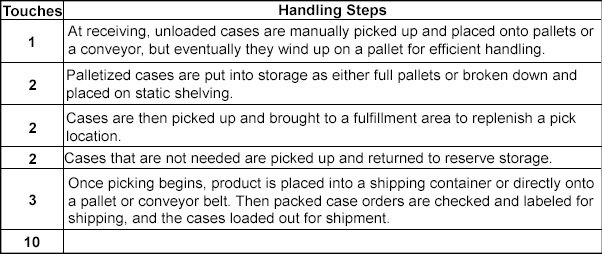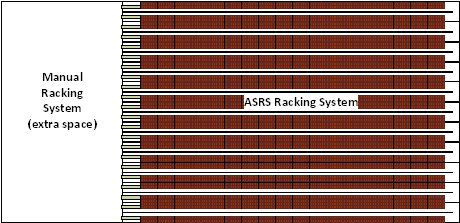
When Does Automating Case Storage Make Economic Sense?
Mike Clemens | 21 March 2013
Over the last few years, I have seen more client interest in automated case storage systems. Several large systems have been installed across the U.S. to provide highly responsive case selection in applications with a lot of SKUs. While the cost justification for some of these installations was based upon very high labor costs; I think the technology costs have dropped to the point where it can have a wider application. How is this possible? I have created some simple examples to illustrate my point. Manual case handling in a warehouse is a pretty common activity; cases can either contain dozens of shirts or maybe a single toaster oven. In a typical warehouse, each product case is handled many times before it is ready for shipment. A simple tracking count (cases touched up to 10 times) could follow these steps:
Automating the case storage handling steps between receiving and picking (storage) can have significant benefits:
- Direct labor savings
- Increased selectivity to support a high SKU operation
- Optimal product slotting
- Higher order fulfillment throughput
- Greater storage density
- High reliability
And a few pitfalls:
- Fixed automation technologies are expensive to change once installed.
- Potential extra costs such as the need for a Warehouse Management System may reduce the payback.
Continuing my example, the automation technology considered is an automated storage and retrieval system (ASRS). This consists of a rail guided stacker crane operating between two rows of carton racking; several aisles of this type of equipment can be grouped together to store a large quantity of cases.
 I kept the equipment as simple as possible to reflect a realistic balance between throughput and inventory storage capacity with two-deep case storage, in standard shelving racking, configured to a storage elevation of thirty feet. (Note - There has been a recent proliferation of different versions of this equipment that can drive the cost up significantly, I have stayed away from these more complex choices.)
I kept the equipment as simple as possible to reflect a realistic balance between throughput and inventory storage capacity with two-deep case storage, in standard shelving racking, configured to a storage elevation of thirty feet. (Note - There has been a recent proliferation of different versions of this equipment that can drive the cost up significantly, I have stayed away from these more complex choices.)
The adjacent table adds up the handling costs for product based upon this scenario with an average U.S. annual labor cost of $44,265 per person (average labor cost with benefits from salary.com for a U.S. warehouse worker, and some typical productivity numbers). Higher labor costs will yield even greater savings. The resulting labor cost per case handled is $ 1.47; after subtracting the case handling savings per case with automated storage, the cost drops by nearly 50% to $0.70. This is accomplished by eliminating 3 handling steps; put-away, replenishment, and picking. Returns were ignored, as we assumed full case picks.  Also, the greater storage density of an automated system can result in a 30% floor space reduction.
Also, the greater storage density of an automated system can result in a 30% floor space reduction.
Using all of the labor, costing, and savings information, I followed traditional steps to develop a business case. To size the automated system, I calculated the number of crane aisles to meet required throughput, then calculated the number of crane aisles to hold required inventory, and finally took the larger crane aisle number to develop a storage layout. I then estimated the cost per crane aisle and also similar costs for a manual racking system with an equivalent number of picking vehicles. The difference between these costs is the incremental investment required for the automated system.
Labor savings are based upon the annual handling cost savings per case times the annual case volume. Space savings were determined by creating a layout of both the automated and manual options to find the square footage reduction and then converting the space savings into the annual rent reduction. The combination of all of the annual savings, divided into the incremental investment required for the automated system yields the investment return.
While there is a significant capital investment required, the calculated cost savings resulted in less than a 3-4 year payback. In summary, this type of technology has come of age and is becoming a practical solution to problems in many warehouses; but it takes a little homework to understand the benefits.
Mike Clemens is a principal consulting engineer with the Bastian Solutions consulting group. Mike has more than 30 years of client engagement experience focused on the development, cost justification and delivery of automated material handling systems for manufacturing and warehousing applications.
Comments
Backyard Unlimited says:
8/28/2018 10:08 AM
Thank you for all of your effort on this blog.
SPS Chauhan says:
8/28/2018 10:08 AM
Excellent Article Mike. Great to Calculate the Payback
phil pustejovsky says:
8/28/2018 10:08 AM
phil pustejovsky
When Does Automating Case Storage Make Economic Sense? | The Material Handling Blog
Leave a Reply
Your email address will not be published.
Comment
Thank you for your comment.